Bush Heritage Australia
Bush Heritage Australia is a non-profit organisation based in Melbourne, Australia, that operates throughout Australia. It was previously known as the Australian Bush Heritage Fund, which is still its legal name. It purchases land, assessed as being of outstanding conservation value, from private owners, to manage as wildlife reserves in perpetuity. It also partners with existing land owners, including Aboriginal groups, to help plan and manage conservation work of important landscapes. It does so to protect endangered species and preserve Australia's biodiversity. By 2019 the organisation was contributing to the protection of 11.3 million hectares on its reserves and partnership lands. There were 6,359 Australian species recorded on their reserves and partnership properties, including 243 threatened species. [5]
 Logo | |
| Motto | Healthy Country Protected Forever |
|---|---|
| Founded | 1990 |
| Focus | Conservation |
| Location |
|
Area served | Australia |
| Method | Acquisition |
Members | 35,000 supporters[1] |
Key people | Bob Brown, Heather Campbell, CEO |
Revenue | A $28,252,000 (2019/March 2020)[2] |
Employees | 105 (full-time equivalent)[3] |
Volunteers | 785[4] |
| Website | bushheritage |
Formerly called | Australian Bush Heritage Fund |
History
Bush Heritage Australia was founded in 1990 by Dr Bob Brown who purchased two forested properties in Tasmania, adjoining the Tasmanian Wilderness World Heritage Site, to save them from being woodchipped. He used the money of his Goldman Environmental Prize as a deposit, borrowing the rest and setting up the Australian Bush Heritage Fund.[6]
The organisation subsequently developed, first in a small way in Tasmania, before expanding to the Australian mainland, and has grown with the assistance of regular subscribers and other donors.
In 1997 Bush Heritage acquired the lease of Erith Island, an island in the Kent Group, Bass Strait, used for cattle grazing. It was relinquished to the Tasmanian Government in 2002 for incorporation into the Kent Group National Park.[7]
In 2011 Bush Heritage entered into a ten-year agreement with the Wunambal Gaambera Aboriginal Corporation, the "first long-term agreement in Australia between traditional landowners and a non-government conservation organisation". The Healthy Country Plan developed by the two groups helps to manage the Indigenous Protected Area (IPA) within the Mitchell River National Park in the Kimberley region in Western Australia.[8]
Aims
Bush Heritage Australia is striving for the long-term protection of Australia's biodiversity through the acquisition and management of land, water and wildlife of outstanding conservation significance. To do so it focuses its attention and investment on broad 'priority landscape' regions across Australia, selected for a combination of criteria, including the number of threatened species and ecosystems, the number of endemic species, and the general condition of the lands within the region. Care of Bush Heritage owned properties includes the rehabilitation of degraded land, the control of introduced herbivores and predators, the use of fire as a management tool, consultation and co-operation with neighbouring landowners and traditional owners, as well as with government departments, and the creation of habitat corridors.
Bush Heritage Australia also has a conservation science program led by Rebecca Spindler.[9] They study public attitude towards conservation as well as the conservation of animal and plant species.[9][10]
Governance
Bush Heritage is run by an independent board of directors skilled in land management and conservation, a number of paid staff and many volunteers. In 2019 Bush Heritage had over 35,000 supporters and hundreds of highly skilled volunteers who contributed 57,000 volunteer hours, and who are given opportunities to visit and work on the reserves. Details of income and expenditure can be found in its Impact Report on its website.
Ambassadors
Bush Heritage Australia has the following ambassadors:
- Chris Darwin (2009–present)
- Phillip Adams
- Steve Parish
- John Williamson
- Roger Woodward
Previous ambassadors include:
- Tim Fischer (2006–2019)
Reserves
As of July 2019, Bush Heritage had 37 reserves & 25 Aboriginal partnerships protecting 11.3 million hectares 113,000 square km, which it owns or co-owns, manages:[11]
|
|
|
See also
References
- https://www.bushheritage.org.au/who-we-are/about/annual-reports
- https://www.bushheritage.org.au/who-we-are/about/annual-reports
- https://www.bushheritage.org.au/who-we-are/people
- https://www.bushheritage.org.au/who-we-are/about/annual-reports
- "Bush Heritage Australia - Impact Report". Bush Heritage Australia. Bush Heritage Australia. 25 July 2019. Retrieved 8 November 2018.
- Our Patron. Bush Heritage Australia.
- Brothers, Nigel; Pemberton, David; Pryor, Helen; & Halley, Vanessa. (2001). Tasmania's Offshore Islands: seabirds and other natural features. Tasmanian Museum and Art Gallery: Hobart. ISBN 0-7246-4816-X
- "Wunambal Gaambera Partnership". Bush Heritage Australia. Retrieved 11 November 2020.
- "Endangered cute critters crucial to WA habitat". The West Australian. 5 June 2018. Retrieved 5 December 2019.
- "Conservation Science". Bush Heritage Australia. Retrieved 5 December 2019.
- . Impact Report - Bush Heritage Australia.
External links
- Bush Heritage Australia – official website
- Biodiversity in the Lake Macquarie Region